RESEARCH
Projections of global health outcomes from 2005 to 2060 using the International Futures integrated forecasting model
Projections de résultats en matière de santé mondiale de 2005 à 2060 en utilisant le modèle prévisionnel intégré International Futures
Proyecciones de los resultados globales de sanidad del 2005 al 2060 utilizando el modelo integrado de predicción de International Futures
Barry B HughesI; Randall KuhnI,*; Cecilia M PetersonI; Dale S RothmanI; José R SolórzanoI; Colin D MathersII; Janet R DicksonI
IJosef Korbel School of International Studies, University of Denver, 2201 S Gaylord Street, Denver, CO, 80208, United States of America
IIHealth Statistics and Informatics, World Health Organization, Geneva, Switzerland
ABSTRACT
OBJECTIVE: To develop an integrated health forecasting model as part of the International Futures (IFs) modelling system.
METHODS: The IFs model begins with the historical relationships between economic and social development and cause-specific mortality used by the Global Burden of Disease project but builds forecasts from endogenous projections of these drivers by incorporating forward linkages from health outcomes back to inputs like population and economic growth. The hybrid IFs system adds alternative structural formulations for causes not well served by regression models and accounts for changes in proximate health risk factors. Forecasts are made to 2100 but findings are reported to 2060.
FINDINGS: The base model projects that deaths from communicable diseases (CDs) will decline by 50%, whereas deaths from both non-communicable diseases (NCDs) and injuries will more than double. Considerable cross-national convergence in life expectancy will occur. Climate-induced fluctuations in agricultural yield will cause little excess childhood mortality from CDs, although other climatehealth pathways were not explored. An optimistic scenario will produce 39 million fewer deaths in 2060 than a pessimistic one. Our forward linkage model suggests that an optimistic scenario would result in a 20% per cent increase in gross domestic product (GDP) per capita, despite one billion additional people. Southern Asia would experience the greatest relative mortality reduction and the largest resulting benefit in per capita GDP.
CONCLUSION: Long-term, integrated health forecasting helps us understand the links between health and other markers of human progress and offers powerful insight into key points of leverage for future improvements.

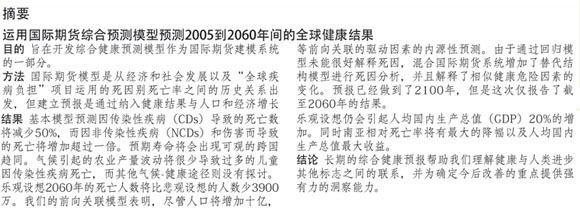
RÉSUMÉ
OBJECTIF: Développer un modèle intégré de prévision sanitaire s'intégrant dans le système de modélisation International Futures (IFs).
MÉTHODES: Le modèle IFs commence avec les relations historiques entre le développement économique et social et la mortalité par cause utilisées par le projet Charge globale de la morbidité, mais il élabore des prévisions à partir de projections endogènes de ces agents en réintégrant des données, comme la population et la croissance économique, aux corrélations aval des résultats sanitaires. Le système hybride IFs ajoute des formulations structurelles alternatives pour des causes mal prises en compte par les modèles de régression et rend compte de modifications dans des facteurs proches de risque sanitaire. Les prévisions sont faites pour 2100 mais les résultats sont exprimés pour 2060.
RÉSULTATS: Le modèle de base prévoit que les morts par maladies contagieuses (MC) baisseront de 50%, tandis que les morts par maladies non contagieuses (MNC) et par blessures feront plus que doubler. Une forte convergence dans l'espérance de vie se produira entre les différents pays. Les fluctuations de la production agricole dues au climat entraîneront un léger excès de mortalité infantile par MC, bien que d'autres approches climat-santé n'aient pas été explorées. Un scénario optimiste produira 39 millions de morts de moins en 2060 qu'un scénario pessimiste. Notre modèle de corrélation en aval suggère qu'un scénario optimiste entraînerait une augmentation du produit intérieur brut (PIB) par tête de 20%, malgré le milliard de personnes supplémentaires. L'Asie du Sud jouirait de la plus forte réduction relative de mortalité et de la plus importante croissance du PIB par tête qui en résultera.
CONCLUSION: La prévision sanitaire intégrée à long terme nous aide à comprendre les liens entre la santé et les autres marqueurs de progrès humain et met en évidence des points d'action clés pour des améliorations futures.
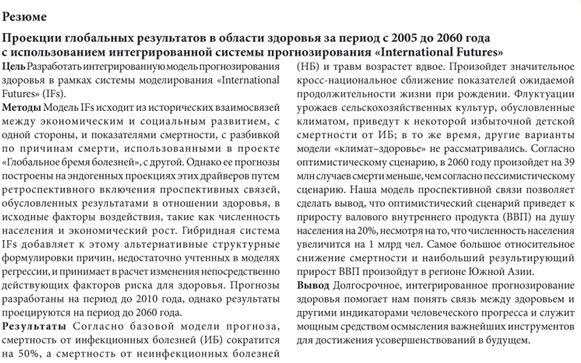
RESUMEN
OBJETIVO: Desarrollar un modelo de predicción de salud integrado como parte del sistema de modelos International Futures (IF).
MÉTODOS: El modelo IF comienza con las relaciones históricas entre desarrollo económico y social y mortalidad por causas específicas, utilizado por el proyecto Global Burden of Disease, pero genera predicciones a partir de proyecciones endógenas de estos causantes, incorporando asociaciones prospectivas de los resultados de salud que se remontan a aportaciones como la población y el crecimiento económico. El sistema híbrido IF añade formulaciones estructurales alternativas para causas no muy bien tratadas en modelos de regresión y tiene en cuenta cambios en factores de riesgo próximos para la salud. Se hacen pronósticos hasta el 2100, pero se informa de los resultados hasta el 2060.
RESULTADOS: El modelo de base proyecta que las muertes por enfermedades transmisibles (ET) disminuirán en un 50%, mientras que las muertes, tanto por enfermedades no transmisibles (ENT) como por lesiones, superarán el doble de lo actual. Se dará una convergencia transnacional apreciable en la esperanza de vida. Las fluctuaciones causadas por el clima en el rendimiento agrícola causarán poco aumento de la mortalidad infantil causada por las ET, aunque no se investigaron otros patrones clima-salud. Una predicción optimista dará 39 millones de muertes menos en el 2060 que una predicción pesimista. Nuestro modelo de asociación prospectiva sugiere que una predicción optimista resultará en un aumento del 20% en el producto interior bruto (PIB) per cápita, a pesar de los mil millones más de personas. El Sur de Asia experimentará la mayor reducción de la mortalidad relativa y el mayor beneficio resultante en el PIB per cápita.
CONCLUSIÓN: La predicción de salud a largo plazo e integrada nos ayuda a entender las relaciones entre la salud y otros marcadores del progreso humano y ofrece una ilustrativa perspectiva en puntos clave de influencia para mejoras futuras.
Introduction
Long-term forecasts of mortality and disease burden are essential for setting current and future health system priorities, yet few forecasts cover a wide range of nations over a long span of time. Even fewer situate changes into an integrated framework to account for the effects of variation in mortality on population size, population age structure and drivers of mortality such as income. This paper describes an approach to address this gap by building a health model into the existing International Futures (IFs) global modelling system (initially developed by Barry B Hughes, Frederick S Pardee Center for International Futures, Josef Korbel School of International Studies, University of Denver, Denver, United States of America).1 IFs is a software tool whose central purpose is to facilitate the exploration of possible global futures through the creation and analysis of alternative scenarios. We build on the work of the World Health Organization's (WHO) Global Burden of Disease (GBD) project, which has produced the only published global forecasts of regional and cause-specific health outcomes to date.2,3 GBD was not, however, designed to produce long-term, integrated forecasts; available analyses extend to 2030, now only 20 years distant.
The need for long-term, integrated forecasting is evident in emerging health risks and population trends. The epidemiologic transition from communicable diseases (CDs) to non-communicable diseases (NCDs) and injuries as leading causes of death demands that models capture complex, long-term relationships such as the effects of global agriculture production on obesityrelated mortality decades later; the effects of infrastructural investment on road traffic accidents; and the potential effects of anthropogenic climate change on a constellation of risk factors for CDs and NCDs.35 The shift from CDs to NCDs reflects population growth and aging, which determine both the number and distribution of deaths in a society. Finally, the burden of disease and population changes can profoundly affect subsequent economic growth and further alter health trajectories in a synergistic fashion.6
Many wealthy nations produce long-term forecasts of age-, sex- and cause-specific death rates and the economic consequences of aging, yet few forecasts are integrated to explore scenarios in which, for example, a major shift in tobacco consumption could simultaneously affect mortality, morbidity, population size or structure and economic productivity. Few poor countries produce any long-range forecasts, yet many are in the midst or on the threshold of the above transitions. Finally, no forecast explores these issues in a global system in which rich and poor countries interact.
In spite of this dearth of forecasting tools, the global community has begun to set global health targets that are both longterm and based on an integrated understanding of health risks. In 2009, the WHO's Commission on the Social Determinants of Health (CSDH) set ambitious targets for reducing gaps in life expectancy, under-5 mortality and adult mortality (i.e. the probability of dying between the ages of 15 and 49 years).7 For example, CSDH aimed to "reduce by 10 years, between 2000 and 2040, the life expectancy at birth (LEB) gap between the one third of countries with the highest and the one third of countries with the lowest LEB levels..."7 Yet no existing model forecasts health over this time horizon.
To begin to address this gap, we have expanded on the GBD project in several ways. IFs forecasts to 2100 allow end-users to explore country-level outcomes, embed mortality and morbidity patterns within larger global systems, forecast proximate drivers (e.g. obesity, child underweight) and replace some regression-based formulations with richer structural formulations. The flexible structure of IFs allows users to vary model assumptions and undertake alternative scenario analysis. This paper introduces the IFs health model and presents results from our base case as well as optimistic and pessimistic scenarios out to 2060. The model is freely available online at www.ifs.du.edu,along with complete technical documentation and results.8,9
Methods
GBD broke new ground with its forecasting approach, measures and methods. It was the first multi-country forecast to disaggregate mortality into multiple causes of death, an important feature because the driver-outcome relationships vary with cause of death and with age and sex.10 Rather than relying on extrapolation techniques, GBD employed a regressionbased approach using independent distal-driver variables to forecast health outcomes. This led to the development of three alternative scenarios of future mortality and morbidity for more than 100 diseases based on differing assumptions regarding income and education for the eight global regions of their analysis. Mathers & Loncar incorporated more extensive data, created regression models specific to low- and lower-middle-income countries, and developed separate projection models for conditions such as human immunodeficiency virus (HIV) infection and acquired immunodeficiency syndrome (AIDS) that are not easily forecast using distal drivers.3
We take another step forward by integrating GBD baseline estimates and formulations into the existing IFs forecasting framework. IFs draws upon standard modelling approaches from a wide range of disciplines including demography, economics, education, politics, agriculture and the environment. For example, the demographic model incorporates a true "cohort-component" representation that tracks country-specific populations and events (including births, deaths and migrations) over time by age and sex.11 The forecast draws on an extensive database of indicators from all relevant disciplines.12 The IFs global health module begins with the GBD models that forecast mortality for each age group as a function of distal drivers that determine health at a societal level: gross domestic product (GDP) per capita; total years of adult education (for adults 25 years of age and older); a smoking impact factor that measured the lagged impact of smoking, and time. While linkage of these mortality outcomes into our existing demographic forecast is an advancement in itself, we further incorporated forward linkages between health and population and development, proximate health drivers and structural representations of some important health issues, as shown in Fig. 1 .

Unlike the GBD project, we forecast distal drivers of mortality, such as income, entirely within the system. IFs already included linkages from changes in mortality to changes in the drivers of health. An example is the effect of an additional surviving person on the labour-capital ratio or the dependency ratio. We added a broader range of pathways through which mortality and disease are known to have an impact on economic growth,6,13,14 including linkages between reduced mortality/morbidity and reduced fertility,15,16 increased human capital and productivity17,18 and increased financial capital.19,20
As the distal driver approach may perform poorly when mortality rates do not bear a straightforward relationship to distal drivers, we incorporate some richer structural formulations. For HIV/ AIDS, a two-stage forecast represents rising and falling prevalence around a peak epidemic year along with secular trends in case-fatality rates.21 Road-traffic accident deaths are tied to the growth of the vehicle fleet (strongly related to income growth but saturating at higher levels) and to the declining rate of accidents and deaths per vehicle (related to income and infrastructural investment). Structural models also forecast smoking impact and the effect of health systems on under-5 mortality.
Finally, we explicitly modelled eight of the proximate risk factors for death identified in the Comparative Risk Assessment (CRA) project: childhood underweight; high body mass index (overweight); smoking; unsafe water and poor sanitation and hygiene; urban air pollution; indoor air pollution from household use of solid fuels; global cli-mate change; vehicle ownership rate and fatality rate.22 Although traditional risk factors such as undernutrition, unsafe water and poor sanitation decline with rising income, other risk factors such as smoking and obesity may rise and, in the case of smoking, eventually fall.2226 We do not address all risk factors or all health outcomes related to the selected risk factors because of limited data and knowledge. As an example, we estimate child undernutrition using a model of food availability that accounts for demand factors such as GDP per capita and for supply factors such as technology, weather and climate change. On looking deeper, national changes in temperature and precipitation are determined by global temperature changes, which are driven by emissions of carbon dioxide from land use change and fossil fuel consumption.
We assessed our integrated model through internal and external validation exercises. First, the IFs database contains data from 1960 forward for many variables. The model compares well in areas for which historic data exist and we used this process to tune the model whenever we found significant discrepancies. Second, we compare our forecasts with other projects focused on single systems, including the GBD, the United Nations Population Division forecasts and country-specific or diseasespecific forecasts.8,23
Results
Base case forecast
Fig. 2 depicts historical and forecast life expectancy at birth by region, from 1960 to 2100. Trends for males and females suggest dramatic improvements in all regions. We forecast particular improvement in poor regions, especially sub-Saharan Africa, resulting from a rapid decline in HIV/AIDS and CDs more generally. Although most sources suggest that the HIV/AIDS epidemic may have peaked, the newness of this trend limits our confidence in the forecast, as we explore in our pessimistic scenario below. We forecast a gradual slowing of improvements in life expectancy in high-income countries, particularly for males. Comparing our results for 2050 with those from the United Nations Population Division, we anticipate comparable but slightly better life expectancy outcomes, with highincome countries experiencing an increase of about one year and low-income countries of about two years.
WHO's CSDH set the goal of reducing the gap in life expectancy at birth between the 65 countries with the longest and shortest life expectancies by 10 years, or from an average of 18.8 years in 2000 to 8.8 years in 2040. Fig. 3 depicts this gap historically and in the IFs base case forecast. This goal appears unlikely to be met until after 2060 (in fact, not until almost the end of the century). This is largely because of continued improvements in life expectancy in high-income countries.
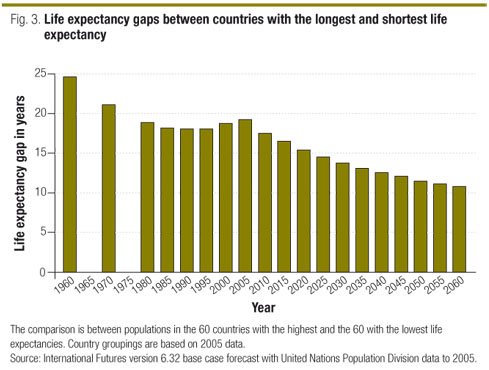
Prospects for achieving such ambitious goals will depend on continued reductions in CD mortality and on action against the rising burden of mortality from NCDs and injuries. Globally, IFs forecasts a shift away from CDs as causes of deaths and towards NCDs, already the major cause of death category in 2005 (Fig. 4). We forecast a reduction in CDs of slightly more than 40% by 2030 and of almost 70% by 2060, in spite of a substantial growth in population. This is consistent with historical patterns of progress against most CDs, though considerable uncertainty attends to the pace of the reduction in HIV/AIDS and malaria. Even in sub-Saharan Africa, we forecast that the balance of deaths will shift towards NCDs by around 2030; by 2060 deaths from NCDs will outnumber deaths from CDs by more than 5 to 1. These shifts reflect changing age-specific death rates and an older population structure.
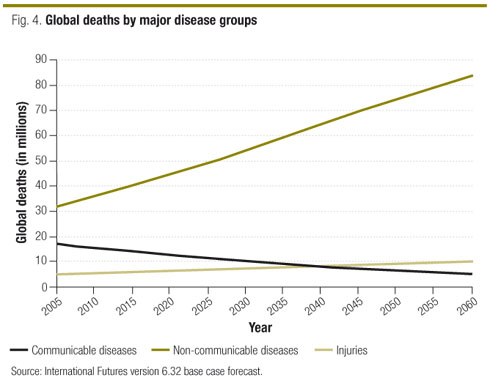
Scenario analysis
In a long-term forecast such as those made by IFs or the GBD project, it is not possible to assess uncertainty by introducing random statistical variation, as this would produce rapidly increasing divergence in the long run and would often produce absurd outcomes. Instead we explored uncertainty via alternate scenarios for key drivers of health, as was done in the GBD project.3 Optimistic and pessimistic forecasts incorporate possible variations in technology (via a 50% increase or decrease in the pace of mortality reduction due to technology over time) and in the proximate drivers of 10 health (via an increase or decrease of one standard error in each proximate risk factor, phased in over time). To better capture potential positive action on the social determinants of health, the optimistic scenario allows countries that are currently not meeting performance expectations, such as the Russian Federation and South Africa, to gradually converge towards the expected performance.2426 Our pessimistic scenario includes two further adjustments. First, to account for the lingering effects of the recent great recession (20082011 in the IFs base case), we modelled reductions in GDP growth in all countries and greater reductions in low-income countries. Finally, although we introduced no direct change in biological assumptions, our pessimistic scenario incorporated slowed reductions in mortality from CDs, particularly HIV/AIDS.27
The optimistic and pessimistic scenarios have significant global implications. Under the pessimistic scenario, 34 million more deaths occur by 2060 than under the optimistic scenario. The gap in death rates is still larger because population differs markedly between the two scenarios: just over 9 billion in the pessimistic scenario and just over 10 billion in the optimistic one, compared with 9.4 billion in the base case. Of the 1 billion additional people in the optimistic scenario, the great majority about 800 million are 65 and older, with 236 million more working-age adults and 39 million fewer people under 15 years of age. Due to population aging and the high probability of some reduction in the risk of CDs, both scenarios suggest an ongoing global shift in disease burden from CDs to NCDs. Under neither scenario will CDs in 2060 account for more than 12% of deaths, though the burden of CDs will be much higher in the pessimistic scenario.
Fig. 5 depicts the variation in critical life-course mortality probabilities based on forecast life table estimates. The CSDH set explicit targets for reducing under-5 mortality by 95% and adult mortality by 50% in all countries, both genders and all social groups between 2004 and 2040. To address a broader spectrum of life-course mortality trends, we also tracked the life table probability of dying between the ages of 60 and 79 as an indicator of older adult mortality. The probability of death differed widely across regions, often by a factor of two or more. Differences were especially large in the case of under-5 mortality, particularly in sub-Saharan Africa and southern Asia. For low-income countries, under the pessimistic scenario an actual increase in child deaths is expected to occur in the coming years and for most of the forecast horizon an excess of three million child deaths will occur under the pessimistic scenario than under the optimistic one.
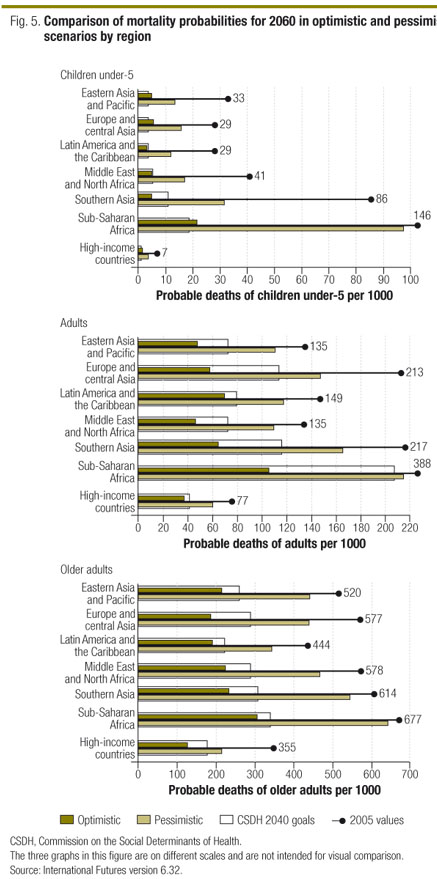
Differences in the adult mortality rate under different scenarios are equally striking, with sub-Saharan Africa and especially southern Asia showing the greatest deviation. For sub-Saharan Africa, the likelihood of some progress against the HIV/AIDS epidemic is so high that adult mortality will be expected to fall from 388 per 1000 in 2005 to 219 per 1000 in 2060, even in the pessimistic scenario. In the optimistic scenario it will fall much further, to 105 per 1000. In southern Asia, Europe and central Asia, where NCDs largely drive adult mortality, the rate of progress over the next half-century differs dramatically in the two scenarios. In southern Asia, the adult mortality rate in 2005 was 217 per 1000. In the optimistic scenario, southern Asia's adult mortality rate drops to 64 per 1000 in 2060, a rate seen in today's high-income societies, whereas in the pessimistic scenario the rate only falls to 165 per 1000.
Fig. 6 presents the variation in regional life expectancy by scenario. In 2005, aggregate life expectancy for sub-Saharan Africa was 28 years lower than the aggregate life expectancy of high-income countries (52 years versus 80), whereas southern Asia's aggregate life expectancy was 15 years lower (65 years versus 80). IFs forecasts considerable convergence in the optimistic scenario, with sub-Saharan Africa's disadvantage narrowing to 12 years by 2060 (80 years versus 92) and southern Asia's narrowing to only 5 years (87 years versus 92). In the pessimistic scenario, however, life expectancy in sub-Saharan Africa will remain 23 years lower than in today's high-income countries (63 years versus 86). Life expectancy in southern Asia would remain 15 years lower than in Europe (71 years versus 86) and ground would be lost with respect to sub-Saharan Africa, a reflection of the high likelihood of reduced mortality from HIV/AIDS in sub-Saharan Africa and future gains in life expectancy in southern Asia resulting from reduced mortality from NCDs.
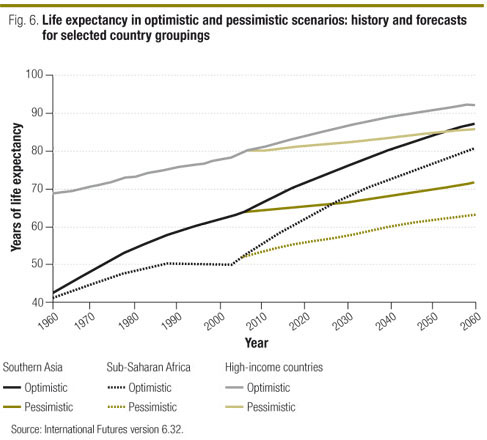
Proximate risk factor variation
While variations in proximate risk factor prevalence included in the optimistic and pessimistic scenarios heavily influence the pace of short-term mortality reductions, their effects erode over time. This is especially true for CD mortality, which is projected to decrease eventually as a result of distal drivers alone but would decline much faster under favourable proximate driver scenarios. We estimate, for instance, that between 2005 and 2060, 131.6 million cumulative deaths from CDs, or 23.4% of total CD deaths, could be eliminated by gradually reducing four proximate drivers: childhood underweight; unsafe water and poor sanitation and hygiene; indoor air pollution, and global climate change. This relatively high population attributable fraction masks substantial variation over time, from 35.6% of CD deaths averted in 2010 to only 7.9% averted in 2060.
Our forecast of substantial declines in baseline CD mortality and childhood underweight sets the context for our climate change impact forecast. As noted above, we only estimate the effects of cli-mate change on childhood underweight through the pathway of diminished food production. In our base run, the atmospheric concentration of carbon dioxide rises to 550 parts per million in 2060, and this translates to a further increase in global temperature of 1.6 ºC from 2005, with specific temperature and precipitation changes at the country level. Fig. 7 presents the projected effect of this additional climate change on mortality from CDs other than HIV/AIDS among children under 5. We ignore any potential positive effects of carbon fertilization on yield. We employ a 10-year moving average to smooth the effects of periodic mortality spikes in countries with low food reserves that are affected by climate change. Such spikes should be anticipated and are important but would not necessarily occur in the exact years we forecast.
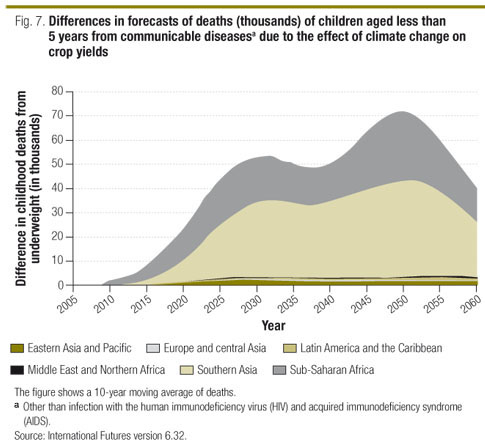
The annual number of additional child deaths caused by CDs exceeds 50 000 by 2030; it peaks in 2050 at over 70 000 and declines thereafter. Most additional deaths occur in southern Asia and sub-Saharan Africa, both characterized by greater food insecurity and higher baseline levels of mortality from CDs. This relatively modest impact reflects declining baseline levels of CD mortality and of childhood underweight due to increased food production in our model. Although this should not be taken as conclusive evidence that climate change has little effect on mortality, it does point to the importance of accounting for baseline improvements in childhood underweight, something not done in several other cli-mate impact forecasts.28
Economic impacts
One final goal of an integrated forecast is to evaluate the potential social and economic effects of various health scenarios. Our analysis suggests that an optimistic health scenario results in positive economic returns relative to the base case, in spite of the demands imposed by population growth. Fig. 8 presents ratios of GDP per capita in the optimistic scenario relative to the base case. In all regions except eastern Asia and the Pacific, the optimistic scenario increases per capita GDP relative to the base case. The different result in eastern Asia and the Pacific stems from the large number of older adults, especially beyond the age of 6079 years, that China will experience relative to its working-age population in the coming years. This change in the age pyramid will also take place to a lesser degree in high-income countries.

In the optimistic scenario, southern Asia would benefit most, followed by sub-Saharan Africa and the Middle East and northern Africa. For southern Asia the change in GDP per capita between the two extreme scenarios reaches 37% in 2060 in spite of increased population. Southern Asia's relative gains stem from the imminent arrival of demographic dividend cohorts into prime working ages; their health will matter considerably. Sub-Saharan Africa would experience about a 22% increase in GDP by 2060, while the Middle East and northern Afthe two extreme scenarios reaches 37% in 2060 in spite of increased population. Southern Asia's relative gains stem from the imminent arrival of demographic dividend cohorts into prime working ages; their health will matter considerably. Sub-Saharan Africa would experience about a 22% increase in GDP by 2060, while the Middle East and northern Africa would gain about 15%. Attention to other aspects of development, including reducing fertility and increasing food production (and therefore feeding larger populations), could further enhance the gains under the optimistic scenario. The gain for sub-Saharan Africa would be especially large, with the 22% percent improvement in GDP per capita from health alone rising to 36%.
Discussion and conclusion
Although the forecasting of human population size and characteristics routinely extends to mid-century or beyond, health forecasting is rare in general and has seldom been performed beyond 2030. Yet an increasing number of global actors and governments take a long-term approach to setting goals for health, as exemplified by the recent work of the CSDH, which set goals to 2040. Societies and global actors not only want to understand what the health of citizens will be like in the future; they also want to know how to improve it.
Our analysis reinforces and extends our understanding of changing global and regional mortality patterns, both those pointing towards improvement almost everywhere and towards a reduction in the burden of CDs as well as those that point to a relative increase in NCDs and injuries. Despite the dramatic improvements in our base case, however, only in the optimistic scenario will they lead to the achievement of the goals set by the CSDH for life course mortality reduction and convergence.
Because human action accounts for much of the difference in the assumptions that underlie our scenarios, action on multiple fronts is critical to attain convergence, particularly for regions that are, like southern Asia, at the threshold of the epidemiologic transition. IFs can be an essential tool for understanding the effectiveness of plausible proximate driver scenarios and interventions, given the likely health trajectories based on distal drivers alone. In the case of climate change, our relatively low estimates of additional child CD deaths resulting from food insecurity illustrate the need for climate impact studies to account for broader processes of change, such as the ongoing trend towards improvements in childhood underweight.
IFs can also account for the potential benefits of health policy interventions via forward linkages to economic growth, education and other markers of human progress. Our model suggests a modest but positive contribution of health to economic growth, particularly in southern Asia and sub-Saharan Africa. Our extensive analysis of possible pathways forecasts positive returns. These effects could be enhanced if investments in family planning, nutrition and education were to attenuate short-term population growth, particularly in areas yet to experience any decline in fertility. The modest economic return, however, suggests the need for caution in using economic returns as a simple justification for health investments; the best justification is always the attainment of better, longer lives.
We would, of course, like to see more things done, including an extension of the set of proximate drivers to include factors such as alcohol use and physical activity level. Our scenario analysis would benefit from a deeper exploration of a variety of extreme events, including major plagues and dramatic breakthroughs in life extension. More immediately, IFs will soon be able to evaluate the potential health and economic impacts of specific policy and governance scenarios beginning with the Global Framework Convention on Tobacco Control. Our chronic disease forecasts would benefit from explicit incidenceprevalence mortality modelling. We could also strive to better capture the social and political context of health, with a representation of subnational variation (beyond sex differences), use of national inequality as a distal driver, and modelling of the spatial and social transmission of health risks from nation to nation. Finally, we reiterate that the system used for this analysis is available for others to use in replication or alternative analysis and to develop further. 
Funding: This work was supported in part by the Frederick S Pardee Center for International Futures at the University of Denver. No funding bodies had any role in study design, data collection and analysis, decision to publish or preparation of the manuscript.
Competing interests: None declared.
References
1. Hughes BB, Hillebrand EE. Exploring and shaping International Futures. Boulder: Paradigm Publishing; 2006.
2. The global burden of disease: 2004 update. Geneva: World Health Organization; 2008.
3. Mathers CD, Loncar D. Projections of global mortality and burden of disease from 2002 to 2030. PLoS Med 2006;3:e442. doi:10.1371/journal. pmed.0030442 PMID:17132052
4. Omran AR. The epidemiologic transition. A theory of the Epidemiology of population change. 1971. Bull World Health Organ 2001;79:16170. PMID: 11246833
5. Prüss-Üstün A, Corvalán CF. Preventing disease through healthy environments: towards an estimate of the environmental burden of disease. Geneva: World Health Organization; 2006.
6. Sachs JD. Macroeconomics and health: investing in health for economic development: report. Geneva: World Health Organization; 2001.
7. Marmot M, Friel S, Bell R, Houweling TA, Taylor S; Commission on Social Determinants of Health. Closing the gap in a generation: health equity through action on the social determinants of health. Lancet 2008;372:16619. doi: 10.1016/S0140-6736(08)61690-6 PMID:18994664
8. Hughes BB, Kuhn R, Peterson CM, Rothman DS, Solorzano JR, Dickson J. Improving global health: patterns in potential human progress. Vol. 3. Boulder: Paradigm Publishers; 2011.
9. Hughes BB, Kuhn R, Peterson CM, Rothman DS, Solorzano JR, Dickson J. Forecasting global Health in IFs: technical documentation. Denver: University of Denver; 2010.
10. Murray CJL, Lopez AD, editors. The global burden of disease: a comprehensive assessment of mortality and disability from diseases, injuries, and risk factors in 1990 and projected to 2020. Cambridge: Harvard University Press; 1996.
11. Preston SH, Heuveline P, Guillot M. Demography: measuring and modeling population processes. Malden: Blackwell; 2001.
12. Chesebro J. The database of Ifs update [Internet]. Denver: University of Denver; 2009. Available from: http://www.ifs.du.edu/assets/documents/theifsdatabase5_09.pdf [accessed 31 March 2011] .
13. Fogel RW, Costa DL. A theory of technophysio evolution, with some implications for forecasting population, health care costs, and pension costs. Demography 1997;34:4966. doi:10.2307/2061659 PMID:9074831
14. Sachs J, Malaney P. The economic and social burden of malaria. Nature 2002;415:6805. doi:10.1038/415680a PMID:11832956
15. Soares RR. Mortality reductions, educational attainment, and fertility choice. Am Econ Rev 2005;95:580601. doi:10.1257/0002828054201486
16. Soares RR. The effect of longevity on schooling and fertility: evidence from the Brazilian Demographic and Health Survey. J Popul Econ 2006;19:7197. doi: 10.1007/s00148-005-0018-y
17. Deaton A. Height, health, and development. Proc Natl Acad Sci USA 2007;104:132327. doi:10.1073/pnas.0611500104 PMID:17686991
18. Grantham-McGregor S, Cheung YB, Cueto S, Glewwe P, Richter L, Strupp B; International Child Development Steering Group. Developmental potential in the first 5 years for children in developing countries. Lancet 2007;369:6070. doi: 10.1016/S0140-6736(07)60032-4 PMID:17208643
19. Weil DN. Accounting for the effect of health on economic growth. Q J Econ 2007;122:1265306. doi:10.1162/qjec.122.3.1265
20. Bloom DE, Canning D, Graham B. Longevity and life-cycle savings. Scand J Econ 2003;105:31938. doi:10.1111/1467-9442.t01-1-00001
21. Stover J, Johnson P, Zaba B, Zwahlen M, Dabis F, Ekpini RE. The Spectrum projection package: improvements in estimating mortality, ART needs, PMTCT impact and uncertainty bounds. Sex Transm Infect 2008;84(Suppl 1):i2430. doi: 10.1136/sti.2008.029868 PMID:18647862
22. Ezzati M, Lopez AD, Rodgers A, Murray CJL, editors. Comparative quantification of health risks: global and regional burden of disease attributable to selected major risk factors. Geneva: World Health Organization; 2004.
23. Hughes BB. Verification, validation, and accreditation of IFs [Internet]. 2006; Available from: http://www.ifs.du.edu/assets/documents/ifsvalidationv1_0.pdf [accessed 31 March 2011] .
24. Shkolnikov V, Cornia G, Leon D, Meslé F. Causes of the Russian mortality crisis: evidence and interpretations. World Dev 1998;26:19952011. doi: 10.1016/S0305-750X(98)00102-8
25. Zaridze D, Maximovitch D, Lazarev A, Igitov V, Boroda A, Boreham J et al. Alcohol poisoning is a main determinant of recent mortality trends in Russia: evidence from a detailed analysis of mortality statistics and autopsies. Int J Epidemiol 2009;38:14353. doi:10.1093/ije/dyn160 PMID:18775875
26. Kuhn R. Routes to low mortality in poor countries revisited. Popul Dev Rev 2010;36:65592. doi:10.1111/j.1728-4457.2010.00353.x PMID: 21174865
27. Fauci AS. Infectious diseases: considerations for the 21st century. Clin Infect Dis 2001;32:67585. doi:10.1086/319235 PMID:11229834
28. Nelson GC, Rosegrant MW, Koo J, Robertson R, Sulser T, Zhu T, et al. Climate change impact on agriculture and costs of adaptation. Washington: International Food Policy Research Institute; 2009.
(Submitted: 18 October 2010 Revised version received: 25 March 2011 Accepted: 25 March 2011 Published online: 8 April 2011)
* Correspondence to Randall Kuhn (e-mail: rkuhn@du.edu).
